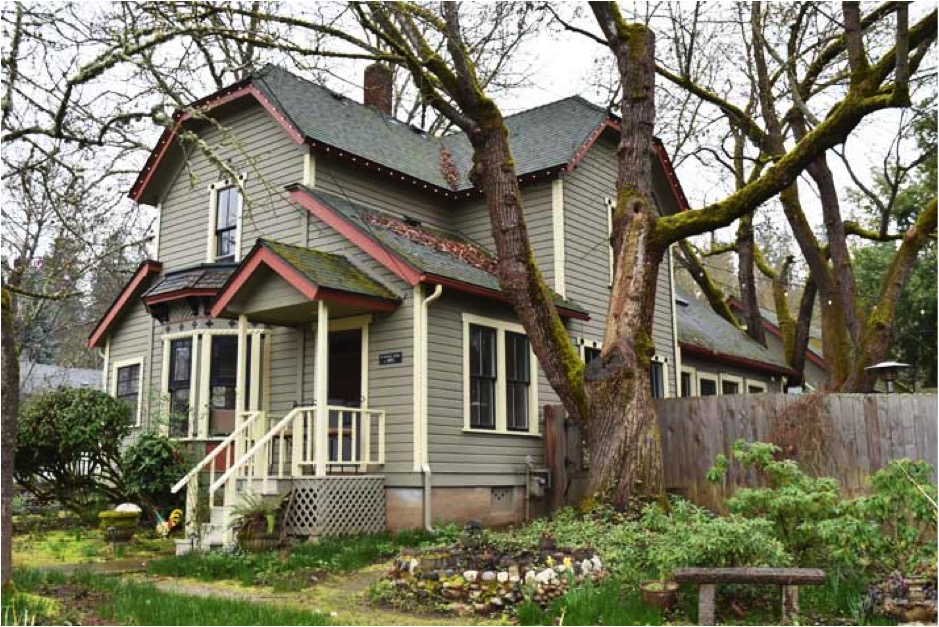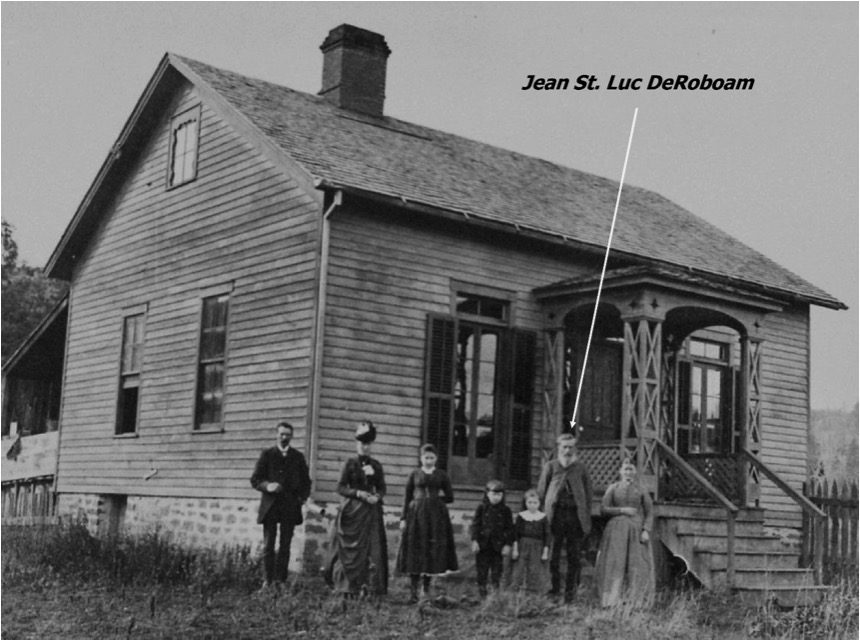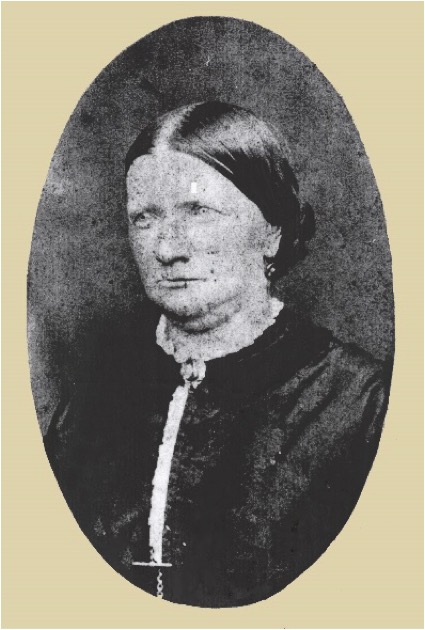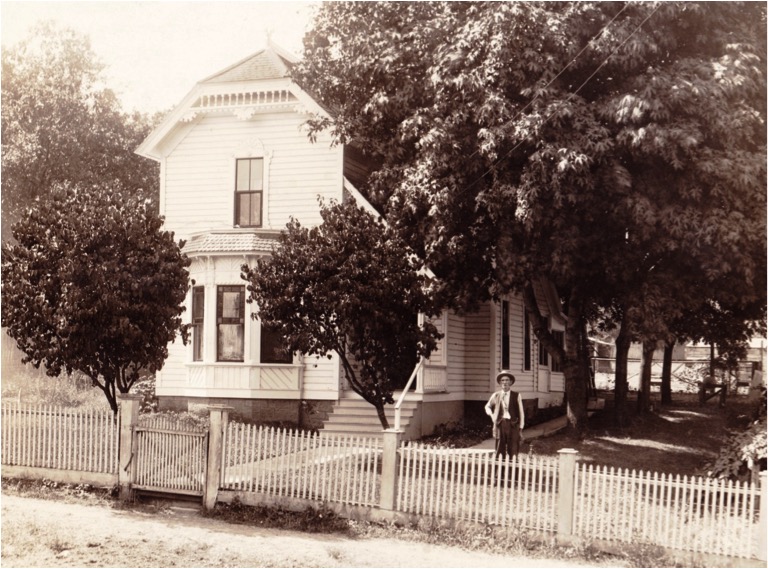|
A Virtual Walk Through Jacksonville History
Stop 18: DeRoboam House
Let’s cross back over East California Street and walk a few doors west to the 1893 Queen Anne style house at number 390. It’s known as the DeRoboam House, and some people think it belonged to Jacksonville’s well-known hotel proprietress, Madame Jeanne DeRoboam Holt, who owned both the Franco-American Hotel and the U.S. Hotel. However, the DeRoboam in this case was her brother, Jean St. Luc DeRoboam—or more accurately, her brother’s second wife, Henrietta Schmidling DeRoboam. And there is quite a back story to this structure!
 DeReboam House, April 2017. Photo Source: Carolyn Kingsnorth DeReboam House, April 2017. Photo Source: Carolyn Kingsnorth
DeRoboam and Schmidling were both widowed when they married in 1873. Following the death of his first wife in 1870, DeRoboam, a native of France, had immigrated to the U.S. with his four children. He had settled in Jacksonville by December 1871 when the Oregon Sentinel noted his arrival and extended him a “hand of welcome.”
 Jean St. Luc DeRoboam Family. Photo Source: SOHS Jean St. Luc DeRoboam Family. Photo Source: SOHS
|
Reports differ as to his activities. One source says he engaged in farming; another says he “established himself in the hotel business,” presumably assisting his sister Jeanne. Probably he did both. The Portrait and Biographical Record describes him as one of the “progressive and well known upbuilders of Jacksonville.”
His career was certainly aided by his second wife. In 1873, DeRoboam married Henrietta Schmidling in a civil ceremony. Schmidling, a native of Prussia, had probably been in the U.S. considerably longer and in the Jacksonville area since the 1850s. Prior to the 1870 death of her husband, she had filed a “Married Women’s Property Rights” claim that included a 644 acre donation land claim; two city lots totaling 96 acres; 120 hogs and 16 head of cattle; all the household and kitchen furniture; and tools and other personal property. In other words, she was a very rich woman.
|
 Henrietta Schmidling. Henrietta Schmidling.
Photo Source: SOHS #16018
|
When DeRoboam’s sister died in 1884, DeRoboam and Henrietta were appointed administrators of Jeanne DeRoboam Holt’s estate. They took over the management of her properties, including her “grand brick” U.S. Hotel at the corner of California and North 3rd streets in Jacksonville. They then set about making many “improvements.” Nothing was left undone “for the comfort of their guests.” As one of their improvements they even converted a portion of the hotel to a roller skating rink “for the pleasure of Jacksonville residents.”
Unfortunately, DeRoboam lacked the business instincts of his sister. With the cost of renovations, he soon accumulated unpaid mortgages, the lenders foreclosed, and the hotel went on the sheriff’s auction block. Henrietta saved the hotel for the family by making the highest bid. Using her own money, she bought the hotel back paying $4,325 in U.S. gold coin.
Now the owner of a hotel, Henrietta decided she also wanted her own residence. In 1890 DeRoboam had purchased the property at 390 E. California Street, and in 1893 Henrietta commissioned her “commodious Queen Anne style” home on that site.
The new structure replaced a wood frame structure and two other “small board houses” that had been owned by Margaret Little and her children. The Little family had owned the acreage itself from as early as 1855. James B. Little had been a sea captain. He drowned at sea around 1859. Margaret Little was a midwife. In the 1880s, one son had established the J.R. Little and Company store in Jacksonville, specializing in “tobacco, cigars, and gents furnishing goods.”
The construction of Henrietta’s house was well documented in Jacksonville’s Democratic Times newspaper. In May 1893, the paper reported that “The dwelling Mrs. H. DeRoboam is having built on her fine large lot on California Street is well under way. When completed it will be one of the neatest and most convenient residences in Southern Oregon. L.F. Christian is the architect and is being assisted by his son and George Riggs.” Other notices appeared in the paper the next month detailing the progress of construction: “Mrs. DeRoboam’s new residence is looming up nicely. It will be a handsome one” and “Mrs. H. DeRoboam’s residence is nearing completion.”
 DeRoboam House, 1890s. Photo Source: SOHS DeRoboam House, 1890s. Photo Source: SOHS
Stylistically, the design for Henrietta’s new home appears to have come from one of the architectural pattern books popular at the time although not from George Barber’s The Cottage Souvenir catalog of house plans that inspired the Nunan House and two other Queen Anne structures in town (which have since burned). The DeRoboam house is one of the few homes in town with a “jerkin head” roof—a combination of gable and hip roofs.
However, Henrietta had only seven years to enjoy her new home. When she died in 1900, she left the residence to Jean St. Luc along with the furniture from the U.S. Hotel, a life interest in that property, and several thousand dollars. DeRoboam’s ownership didn’t last. When he died in 1913, he was living with his son Samuel. Two years later Jean St. Luc DeRoboam’s properties went to Jackson County for unpaid taxes.
Sources Cited:
Allen, McMath, Hawkins Architects, Jacksonville Historical Survey, April 1980.
Kingsnorth, Carolyn. “Pioneer Profiles,” Jacksonville Review, April 2017.
Oregon Sentinel, December 1871.
Democratic Times, May 1893.
Ibid. June 1893.
|